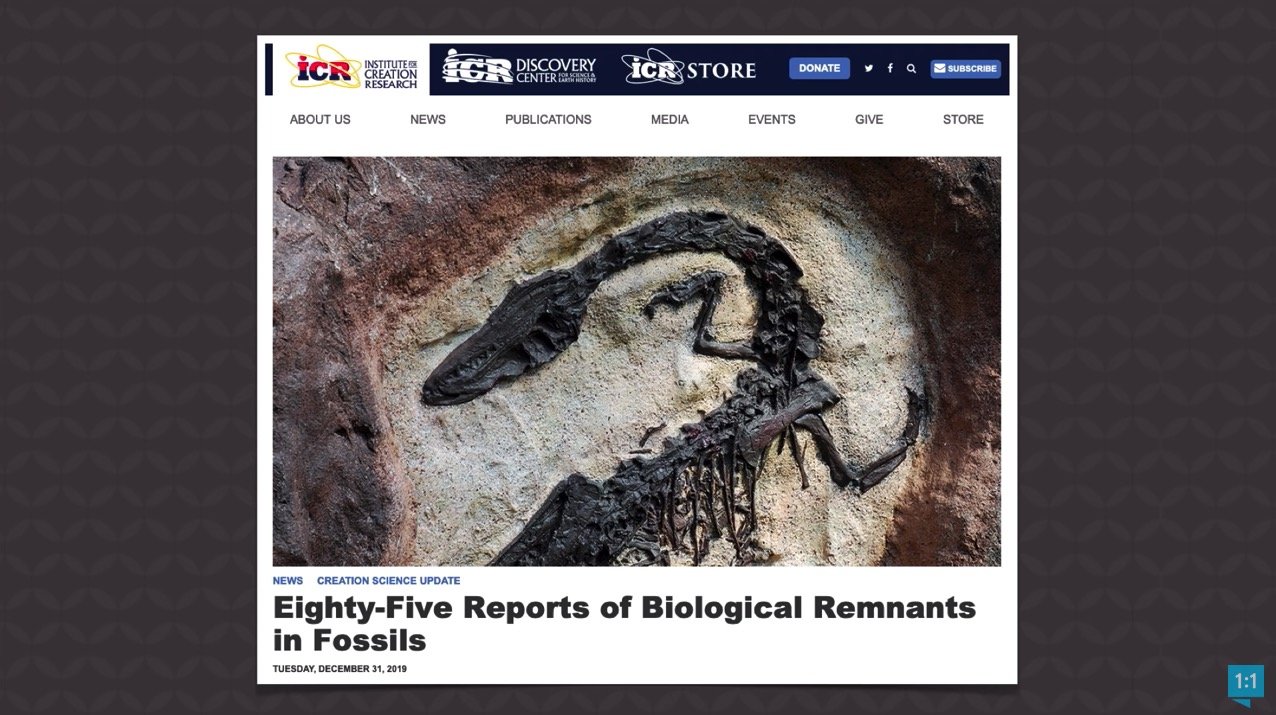
Biological Remnants in Fossils—They’re Common!
A scientific journal recently published a review of eighty-five reports of “organic remains in fossils.” These included “blood vessels, dried but intact skin, and connective tissues on or inside fossils like dinosaur bones . . . red blood cells and bone cells . . . [and] biochemicals specific to animals (not microbes), including proteins, collagen, elastin, ovalbumin, and keratin.” What was the big takeaway for them from this incredible report? You’ll have to read on to find out!
The Institute for Creation Research wrote an excellent article on the above review. It states that the reports in this review “call for a vast rethink of the mainstream age of fossils,” having revealed these three trends:
-
Diversity: These biological remnants aren’t coming from just one select group of fossils. They’re found in “dinosaur, bird, mammal, plant, reptile, amphibian, clam, insect and other arthropods, sponge, and worm fossils.”
-
Geographic distribution: These remnants are found all over the world, including offshore sites. The only exceptions are Australia and Antarctica, for now. ICR asks a good question: “shouldn’t a global effect call for a global cause?”
-
“Age”: These remnants are found in a wide variety of layers, including the Cambrian and below. According to secular dating, that puts these remnants at half a billion years old or more. Soft tissue—unfossilized—has lasted half a billion years? Now that’s a fairy tale!
What do the researchers writing this report think might explain all these soft tissues and the supposed incredible ages? . . . They basically just say they aren’t sure.
So, what was the big takeaway? What do the researchers writing this report think might explain all these soft tissues and the supposed incredible ages? Well . . . they don’t really know. They admit the soft tissues really shouldn’t be there if they’re millions of years of age, and that experiments confirm that things such as proteins can’t last that long. But they don’t question the ages of the fossils. They basically just say they aren’t sure.
You see, evolutionists must have millions and billions of years even to try to propose their (false) ideas of evolution.
Well, I can give them the answer! These fossils are not millions or hundreds of millions of years old! And the reason why finding such tissues is a global phenomenon is because of a global event! These fossils were rapidly and catastrophically buried during the worldwide flood of Noah’s day, around 4,350 years ago. That’s only a few thousand years, not millions!
When we start with God’s Word, we can make sense of what we observe in the world. Without the history God has given us in his Word, researchers are left with fairy tales and data that makes no sense within their worldview. Science always confirms the Bible!
Get More Answers on Answers News
This item was discussed Monday on Answers News with cohosts Avery Foley, Dr. Gabriela Haynes, and Bodie Hodge. Answers News is our weekly news program filmed live before a studio audience here at the Creation Museum and broadcast on my Facebook page and the Answers in Genesis Facebook page. We also covered the following topics:
- The United Methodist Church is not so united anymore.
- Aliens are out there . . . we just can’t see them.
- Elderly woman fights to keep her life support in US hospital.
- And more!
Watch the entire episode of Answers News for January 13, 2019.
Be sure to join us each Monday at 2 p.m. (ET) for Answers News. You won’t want to miss this unique news program that gives science and culture news from a distinctly biblical and Christian perspective.
Thanks for stopping by and thanks for praying,
Ken
This item was written with the assistance of AiG’s research team.
Most Recent News
-
April 22, 2024 from Ken Ham Blog
Colorado law is all too happy to let medical staff prescribe the “abortion pill” (RU-486) to their patients, but it’s not so willing to allow for reversal.
-
April 18, 2024 from Ken Ham Blog
The evolutionary model is not clear about when flowering plants arrived on earth. Evolutionists remain unsure when the angiosperms emerged.

Answers in Genesis is an apologetics ministry, dedicated to helping Christians defend their faith and proclaim the good news of Jesus Christ.
- Customer Service 800.778.3390
- © 2024 Answers in Genesis



